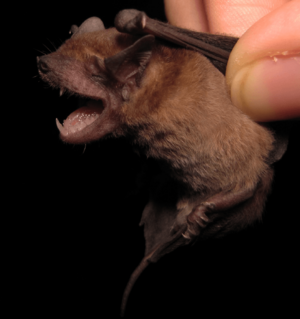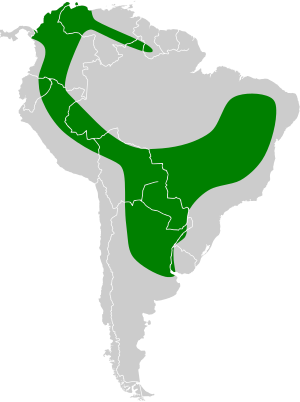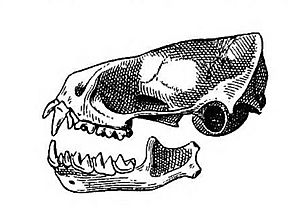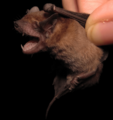Dwarf dog-faced bat facts for kids
Quick facts for kids Dwarf dog-faced bat |
|
|---|---|
 |
|
| Conservation status | |
| Scientific classification | |
| Genus: |
Molossops
|
| Species: |
temminckii
|
 |
|
The dwarf dog-faced bat (Molossops temminckii) is a small bat found in South America. It lives in many countries, including Argentina, Brazil, and Peru. This bat usually lives in lower areas. It is one of only two species in its group, called Molossops. The other is the rufous dog-faced bat.
This bat is quite small. Its forearm is about 2.9 to 3.3 centimeters long. It weighs only 5 to 8 grams, which is less than a typical candy bar! Male bats are a bit bigger than females. Its fur is brown, with a lighter belly and darker back. Its wings are special for a free-tailed bat. They have very wide tips. This means it flies more like a vesper bat than other bats in its own family. The dwarf dog-faced bat hunts insects at night. It uses special sounds, called echolocation, to find its prey and fly around.
Not much is known about how these bats have babies. Females have been found pregnant from July to December. They might be able to have babies more than once a year. These bats live in small groups, usually three or fewer. They can be found under tree bark, in rocks, or even inside buildings. Owls might hunt them, but we don't know how often. They can also have many tiny creatures living on or inside them, like mites and ticks.
Contents
About the Dwarf Dog-Faced Bat
How it Got its Name
The dwarf dog-faced bat was first studied in 1842. But the name given then wasn't fully accepted. Later, in 1854, a German zoologist named Hermann Burmeister properly described it. So, he is given credit for naming it. The bat's scientific name, temminckii, honors a Dutch zoologist named Coenraad Jacob Temminck.
In 1907, an American zoologist, Gerrit Smith Miller Jr., put this bat into the Molossops group. Today, the dwarf dog-faced bat and the rufous dog-faced bat are the only two species in this group. Scientists use special tests to see how bats are related. These tests show that Molossops bats are close relatives to bats in the Cynomops group.
What it Looks Like
The dwarf dog-faced bat is small for a free-tailed bat. Its total length is about 6 to 8.4 centimeters. Its tail is about 2.1 to 3.4 centimeters long. Males are larger than females, especially their skulls.
The fur on its back can be dark or light brown. Bats living in forests often have darker fur. Their belly fur is usually lighter and grayish. This bat has small, triangle-shaped ears. Its skull is flat on top. The snout is long and flat, with a blunt tip. Males have a special gland on their throat. They use this gland to mark their territory or other bats in their group with a scent.
Its thumbs are short but strong, with a good pad at the bottom. It has special cartilage spurs, called calcars, on its tail membrane. These spurs are more than half the length of its hind foot. Its wings attach to its legs in the middle of the shin bone. The wings are large and wide. This means they have a lot of wing area for their body weight. This helps them fly well. The tips of their wings are very wide for a free-tailed bat. You can tell this bat apart from the rufous dog-faced bat because it is smaller. The rufous dog-faced bat has a forearm longer than 3.6 centimeters.
Biology and Ecology
Reproduction
We don't know a lot about how these bats have babies. Pregnant females have been found in different months across their range. For example, in July in Venezuela and in September and December in Brazil. Some scientists think females might be able to get pregnant several times a year. This is different from some bats that only have one breeding season. When two pregnant females were found in Argentina, each had one baby.
Behavior
The dwarf dog-faced bat is somewhat social. It usually lives in small groups of three or fewer bats. However, groups of up to fifteen bats have been found. They often roost, or rest, under the bark of Pithecellobium trees. They can also use rocky areas, buildings, hollow trees, or even hollow fence posts as roosts. These bats are nocturnal, meaning they are active at night. They leave their roosts around sunset to hunt for food.
Diet and Foraging
The dwarf dog-faced bat is an insectivore, which means it eats insects. It catches insects while flying. Even though it's a free-tailed bat, it flies slower than most bats in its family. Its flight is more like a vesper bat. It's thought to fly at about 6.3 kilometers per hour.
It uses echolocation to find its way and catch prey. It makes two kinds of calls. The first type of call is used when it's flying in open areas or looking for food. These calls start at about 40 kHz and end at 50 kHz. They last about 7.8 milliseconds. The second type of call is used when it's flying in crowded places or getting close to an insect. These calls are shorter, lasting about 4.7 milliseconds. They are also closer together. These special calls help the bat find small insects even when there's a lot of other stuff around, like trees. Its diet includes beetles, moths, flies, and grasshoppers.
Predators and Parasites
Not much is known about what animals hunt the dwarf dog-faced bat. However, its remains were once found in a pellet from a barn owl in Argentina. This suggests owls might be predators.
These bats can also have many tiny creatures living on or inside them. Internal parasites include different kinds of worms, like nematodes and cestodes. External parasites include ticks and mites. They can also have special bat flies and true bugs living on their bodies.
Where it Lives
The dwarf dog-faced bat lives only in South America. It has a wide range, found in Argentina, Bolivia, Brazil, Colombia, Ecuador, Guyana, Paraguay, Peru, Uruguay, and Venezuela. It usually lives in lower areas. The highest place it has been found is about 770 meters above sea level in Colombia.
You can find this bat in many different types of environments. These include the Amazonian lowlands, tropical savannas (like the Cerrado), dry shrublands (like the Caatinga), wetlands (like the Pantanal), and different kinds of forests.
Images for kids
See also
 In Spanish: Molossops temminckii para niños
In Spanish: Molossops temminckii para niños





